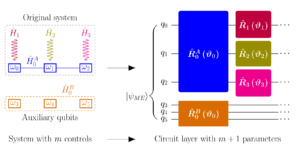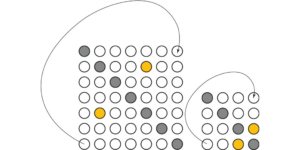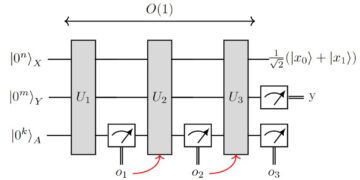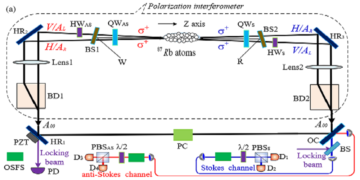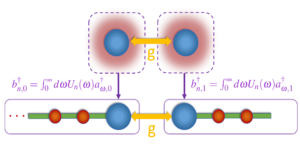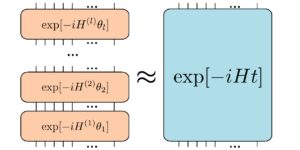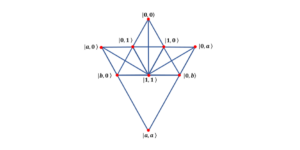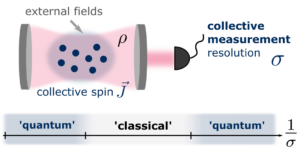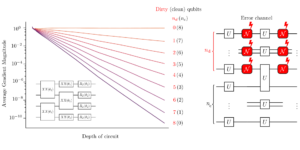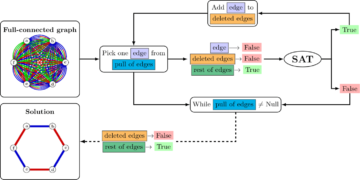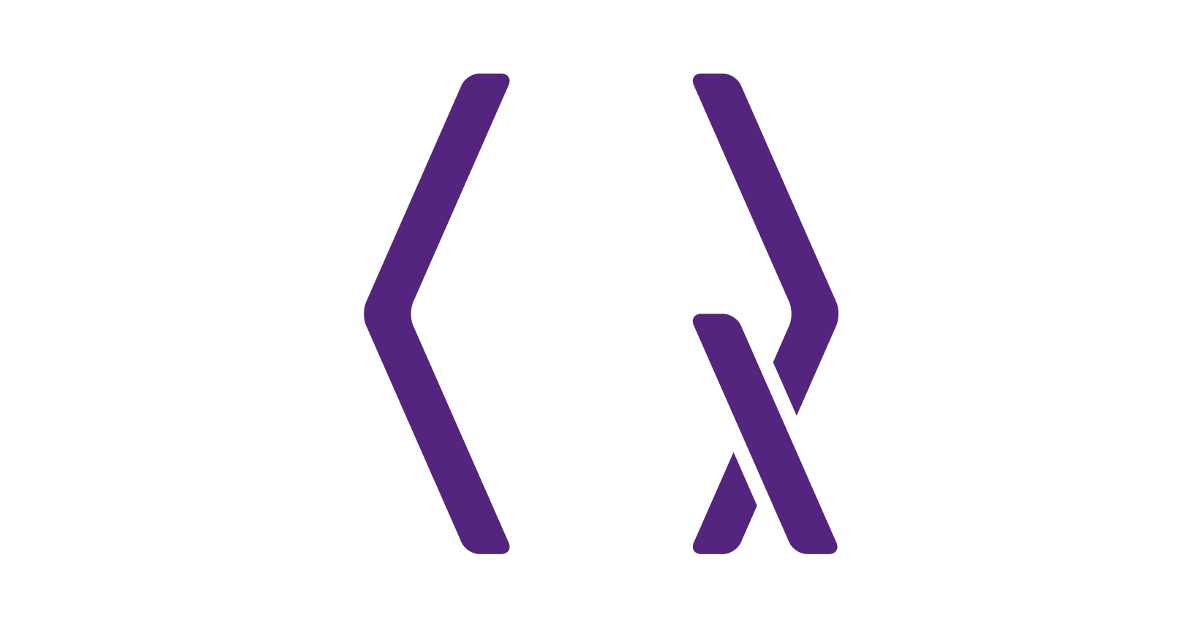
1Microsoft Quantum, Redmond, WA, SUA
2Microsoft Quantum, Toronto, ON, CA
3Facebook AI Research, Seattle, WA, SUA
4Universitatea din Oxford, Oxford, Marea Britanie
5Institutul Heilbronn pentru Cercetare Matematică, Universitatea din Bristol, Bristol, Marea Britanie
6Universitatea din Birmingham, Birmingham, Marea Britanie
7Université Libre de Bruxelles, Bruxelles, Belgia
Găsiți această lucrare interesant sau doriți să discutați? Scite sau lasă un comentariu la SciRate.
Abstract
Oferim o procedură nouă pentru aproximarea unităților generale cu un singur qubit dintr-un set de porți universale finite prin reducerea problemei la o nouă problemă de aproximare a mărimii, realizând o îmbunătățire imediată a lungimii secvenței cu un factor de 7/9. Extinderea lucrărilor [28] Și [15], arătăm că luând amestecuri probabilistice de canale pentru a rezolva fallback [13] și problemele de aproximare a mărimii economisesc un factor de doi în costurile de aproximare. În special, peste setul de porți Clifford+$sqrt{mathrm{T}}$ atingem un număr mediu de porți non-Clifford de $0.23log_2(1/varepsilon)+2.13$ și T-count $0.56log_2(1/varepsilon)+5.3 $ cu aproximări mixte de rezervă pentru precizia normei de diamant $varepsilon$.
Această lucrare oferă o privire de ansamblu asupra aproximării porților, pe lângă aceste noi perspective. Oferim o procedură de la capăt la capăt pentru aproximarea porților pentru seturi de porți generale legate de unele algebre cuaternioane, oferind exemple pedagogice folosind seturi de porți tolerante la erori comune (V, Clifford+T și Clifford+$sqrt{mathrm{T}}$) . De asemenea, oferim rezultate numerice detaliate pentru seturile de porți Clifford+T și Clifford+$sqrt{mathrm{T}}$. Într-un efort de a menține lucrarea autonomă, includem o prezentare generală a algoritmilor relevanți pentru enumerarea punctelor întregi și rezolvarea ecuațiilor de normă relativă. Oferim o serie de aplicații suplimentare ale problemelor de aproximare a mărimii, precum și algoritmi îmbunătățiți pentru sinteza exactă, în Anexe.
► Date BibTeX
► Referințe
[1] Frank Arute, Kunal Arya, Ryan Babbush, Dave Bacon, Joseph C. Bardin, Rami Barends, Rupak Biswas, Sergio Boixo, Fernando GSL Brandao, David A. Buell, Brian Burkett, Yu Chen, Zijun Chen, Ben Chiaro, Roberto Collins, William Courtney, Andrew Dunsworth, Edward Farhi, Brooks Foxen, Austin Fowler, Craig Gidney, Marissa Giustina, Rob Graff, Keith Guerin, Steve Habegger, Matthew P. Harrigan, Michael J. Hartmann, Alan Ho, Markus Hoffmann, Trent Huang, Travis S. Humble, Serghei V. Isakov, Evan Jeffrey, Zhang Jiang, Dvir Kafri, Kostyantyn Kechedzhi, Julian Kelly, Paul V. Klimov, Sergey Knysh, Alexander Korotkov, Fedor Kostritsa, David Landhuis, Mike Lindmark, Erik Lucero, Dmitry Lyakh, Salvatore Mandrà, Jarrod R. McClean, Matthew McEwen, Anthony Megrant, Xiao Mi, Kristel Michielsen, Masoud Mohseni, Josh Mutus, Ofer Naaman, Matthew Neeley, Charles Neill, Murphy Yuezhen Niu, Eric Ostby, Andre Petukhov, John C. Platt, Chris Quintana, Eleanor G. Rieffel, Pedram Roushan, Nicholas C. Rubin, Daniel Sank, Kevin J. Satzinger, Vadim Smelyanskiy, Kevin J. Sung, Matthew D. Trevithick, Amit Vainsencher, Benjamin Villalonga, Theodore White, Z. Jamie Yao , Ping Yeh, Adam Zalcman, Hartmut Neven și John M. Martinis, „Quantum supremacy using a programmable superconducting processor” Nature 574, 505-510 (2019).
https://doi.org/10.1038/s41586-019-1666-5
[2] Wojciech Banaszczyk „Inegalități pentru corpuri convexe și rețele reciproce polare în $R^n$” Discrete & Computational Geometry 13, 217–231 (1995).
https: / / doi.org/ 10.1007 / BF02574039
[3] Adriano Barenco, Charles H. Bennett, Richard Cleve, David P. DiVincenzo, Norman Margolus, Peter Shor, Tycho Sleator, John A. Smolin și Harald Weinfurter, „Elementary Gates for quantum calculation” Physical Review A 52, 3457–3467 ( 1995).
https: / / doi.org/ 10.1103 / PhysRevA.52.3457
[4] Andreas Blass, Alex Bocharov și Yuri Gurevich, „Optimal ancilla-free Pauli+V circuits for axial rotations” Journal of Mathematical Physics 56, 122201 (2015).
https: / / doi.org/ 10.1063 / 1.4936990
arXiv: 1412.1033
[5] Michael Beverland, Earl Campbell, Mark Howard și Vadym Kliuchnikov, „Limite inferioare ale resurselor non-Clifford pentru calcule cuantice” Quantum Science and Technology 5, 035009 (2020).
https: / / doi.org/ 10.1088 / 2058-9565 / ab8963
arXiv: 1904.01124
[6] Michael E. Beverland, Prakash Murali, Matthias Troyer, Krysta M. Svore, Torsten Hoefler, Vadym Kliuchnikov, Guang Hao Low, Mathias Soeken, Aarthi Sundaram și Alexander Vaschillo, „Assessing requirements to scale to practice quantum benefit” (2022).
https:///doi.org/10.48550/arXiv.2211.07629
arXiv: 2211.07629
[7] Jean Bourgain și Alex Gamburd „A Spectral Gap Theorem in SU$(d)$” Journal of the European Mathematical Society 14, 1455–1511 (2012).
https: / / doi.org/ 10.4171 / Jems / 337
[8] Alex Bocharov, Yuri Gurevich și Krysta M. Svore, „Efficient Descomposition of Single-Qubit Gates into V Basis Circuits” Physical Review A 88, 1–13 (2013).
https: / / doi.org/ 10.1103 / PhysRevA.88.012313
arXiv: 1303.1411
[9] Sergey Bravyi și Alexei Kitaev „Calcul cuantic universal cu porți Clifford ideale și ancillari zgomotoase” Fizica. Rev. A 71, 022316 (2005).
https: / / doi.org/ 10.1103 / PhysRevA.71.022316
[10] Sergey Bravyi și Robert König „Clasificarea porților protejate topologic pentru codurile stabilizatoarelor locale” Fiz. Rev. Lett. 110, 170503 (2013).
https: / / doi.org/ 10.1103 / PhysRevLett.110.170503
[11] Michael E. Beverland, Aleksander Kubica și Krysta M. Svore, „Cost of Universality: A Comparative Study of the Overhead of State Distillation and Code Switching with Color Codes” PRX Quantum 2, 020341 (2021).
https: / / doi.org/ 10.1103 / PRXQuantum.2.020341
[12] Alex Bocharov, Martin Roetteler și Krysta M Svore, „Sinteza eficientă a circuitelor cuantice universale cu repetare până la succes” Physical Review Letters 114, 080502 (2015).
https: / / doi.org/ 10.1103 / PhysRevLett.114.080502
arXiv: 1404.5320
[13] Alex Bocharov, Martin Roetteler și Krysta M. Svore, „Sinteza eficientă a circuitelor cuantice probabilistice cu rezervă” Physical Review A 91, 052317 (2015).
https: / / doi.org/ 10.1103 / PhysRevA.91.052317
arXiv: 1409.3552
[14] Vera von Burg, Guang Hao Low, Thomas Häner, Damian S. Steiger, Markus Reiher, Martin Roetteler și Matthias Troyer, „Quantum computing enhanced computational catalysis” Phys. Rev. Research 3, 033055 (2021).
https: / / doi.org/ 10.1103 / PhysRevResearch.3.033055
[15] Earl Campbell „Secvențe de poartă mai scurte pentru calculul cuantic prin amestecarea unitarelor” Physical Review A 95 (2017).
https: / / doi.org/ 10.1103 / PhysRevA.95.042306
arXiv: 1612.02689
[16] Andrew M. Childs, Yuan Su, Minh C. Tran, Nathan Wiebe și Shuchen Zhu, „Theory of Trotter Error with Commutator Scaling” Phys. Rev. X 11, 011020 (2021).
https: / / doi.org/ 10.1103 / PhysRevX.11.011020
[17] Denis X. Charles, Kristin E. Lauter și Eyal Z. Goren, „Cryptographic Hash Functions from Expander Graphs” Journal of Cryptology 22, 93–113 (2009).
https: / / doi.org/ 10.1007 / s00145-007-9002-x
[18] Henri Cohen „Subiecte avansate în teoria numerelor computaționale” Springer New York (2000).
https://doi.org/10.1007/978-1-4419-8489-0
[19] Henri Cohen „Un curs de teoria numerelor algebrice computaționale” Springer Berlin Heidelberg (1993).
https://doi.org/10.1007/978-3-662-02945-9
[20] Set de date pentru circuite cuantice mai scurte (2023).
https:///azure-quantum-notebooks.azurefd.net/publicdata/shorter-quantum-circuits-dataset.tar
[21] Bryan Eastinand Emanuel Knill „Restricții privind seturile de porți cuantice codificate transversale” Fizic. Rev. Lett. 102, 110502 (2009).
https: / / doi.org/ 10.1103 / PhysRevLett.102.110502
[22] Simon Forest, David Gosset, Vadym Kliuchnikov și David McKinnon, „Sinteza exactă a unităților cu un singur qubit peste seturile de porți ciclotomice Clifford” Journal of Mathematical Physics 56, 082201 (2015).
https: / / doi.org/ 10.1063 / 1.4927100
[23] Daniel Gottesman și Isaac L. Chuang „Demonstrarea viabilității calculului cuantic universal folosind operații de teleportare și un singur qubit” Nature 402, 390–393 (1999).
https: / / doi.org/ 10.1038 / 46503
[24] Craig Gidney și Austin G. Fowler „Fabrici de stat magice eficiente cu o transformare catalizată de $|CCZ⟩$ la $2|T⟩$” Quantum 3, 135 (2019).
https://doi.org/10.22331/q-2019-04-30-135
[25] Joachim von zur Gathenand Jürgen Gerhard „Modern Computer Algebra” Cambridge University Press (2013).
https: / / doi.org/ 10.1017 / CBO9781139856065
[26] Craig Gidney „Înjumătățirea costului adăugării cuantice” Quantum 2, 74 (2018).
https://doi.org/10.22331/q-2018-06-18-74
[27] David Gosset, Vadym Kliuchnikov, Michele Mosca și Vincent Russo, „An Algorithm for the T-Count” Quantum Info. Calculator. 14, 1261–1276 (2014).
https:///doi.org/10.48550/arXiv.1308.4134
[28] Matthew B. Hastings „Transformarea erorilor de sinteză de poartă în erori incoerente” Quantum Information and Computation 17, 488–494 (2017).
https:///doi.org/10.48550/arXiv.1612.01011
arXiv: 1612.01011
[29] Aram W. Harrow, Benjamin Recht și Isaac L. Chuang, „Efficient discrete aproximations of quantum gates” Journal of Mathematical Physics 43, 4445–4451 (2002).
https: / / doi.org/ 10.1063 / 1.1495899
[30] Kenneth Ireland și Michael Rosen „A Classical Introduction to Modern Number Theory” Springer New York (1990).
https://doi.org/10.1007/978-1-4757-2103-4
[31] Raban Iten, Roger Colbeck, Ivan Kukuljan, Jonathan Home și Matthias Christandl, „Circuite cuantice pentru izometrii” Phys. Rev. A 93, 032318 (2016).
https: / / doi.org/ 10.1103 / PhysRevA.93.032318
[32] Raban Iten, Oliver Reardon-Smith, Emanuel Malvetti, Luca Mondada, Gabrielle Pauvert, Ethan Redmond, Ravjot Singh Kohli și Roger Colbeck, „Introduction to UniversalQCompiler” (2021).
https:///doi.org/10.48550/arXiv.1904.01072
arXiv: 1904.01072
[33] Nathaniel Johnston, David W. Kribs și Vern I. Paulsen, „Computing Stabilized Norms for Quantum Operations via theory of Completely Bounded Maps” Quantum Info. Calculator. 9, 16–35 (2009).
https:///doi.org/10.48550/arXiv.0711.3636
[34] Aleksandr Yakovlevich Khinchin „O formulare cantitativă a teoriei aproximării a lui Kronecker” Izvestiya Rossiiskoi Akademii Nauk. Seriya Matematicheskaya 12, 113–122 (1948).
[35] V Kliuchnikov, A Bocharov, M Roetteler și J Yard, „A Framework for Approximating Qubit Unitaries” (2015).
https:///doi.org/10.48550/arXiv.1510.03888
arXiv: 1510.03888
[36] Phillip Kaye, Raymond Laflamme și Michele Mosca, „O introducere în calculul cuantic” Oxford University Press (2006).
https: / / doi.org/ 10.1093 / oso / 9780198570004.001.0001
[37] V Kliuchnikov, D Maslov și M Mosca, „Asimptotic Optimal Aproximation of Single Qubit Unitaries by Clifford and T Circuits Using a Constant Number of Ancillary Qubits” Physical Review Letters 110, 190502 (2013).
https: / / doi.org/ 10.1103 / PhysRevLett.110.190502
arXiv: 1212.0822
[38] Vadym Kliuchnikov, Dmitri Maslov și Michele Mosca, „Sinteza exactă rapidă și eficientă a unităților cu un singur qubit generate de Clifford și T Gates” Quantum Info. Calculator. 13, 607–630 (2013).
https:///doi.org/10.48550/arXiv.1206.5236
[39] V Kliuchnikovand J Yard „Un cadru pentru sinteza exactă” (2015).
https:///doi.org/10.48550/arXiv.1504.04350
arXiv: 1504.04350
[40] Guang Hao Low și Isaac L. Chuang „Simulare Hamiltoniană optimă prin procesare cuantică a semnalului” Fiz. Rev. Lett. 118, 010501 (2017).
https: / / doi.org/ 10.1103 / PhysRevLett.118.010501
[41] Franz Lemmermeyer „Algoritmul euclidian în câmpurile numerice algebrice” Expositiones Mathematicae 13, 385–416 (1995).
[42] HW Lenstra „Programare cu numere întregi cu un număr fix de variabile” Mathematics of Operations Research 8, 538–548 (1983).
https: / / doi.org/ 10.1287 / moor.8.4.538
[43] Daniel Litinski „A Game of Surface Codes: Large-Scale Quantum Computing with Lattice Surgery” Quantum 3, 128 (2019).
https://doi.org/10.22331/q-2019-03-05-128
[44] AK Lenstra, HW Lenstra și L. Lovász, „Factorizarea polinoamelor cu coeficienți raționali” Mathematische Annalen 261, 515–534 (1982).
https: / / doi.org/ 10.1007 / BF01457454
[45] A. Lubotzky, R. Phillips, and P. Sarnak, „Ramanujan graphs” Combinatorica 8, 261–277 (1988).
https: / / doi.org/ 10.1007 / BF02126799
[46] Easwar Magesan, Jay M. Gambetta și Joseph Emerson, „Caracterizarea porților cuantice prin benchmarking randomizat” Phys. Rev. A 85, 042311 (2012).
https: / / doi.org/ 10.1103 / PhysRevA.85.042311
[47] Emanuel Malvetti, Raban Iten și Roger Colbeck, „Circuite cuantice pentru izometrii rare” Quantum 5, 412 (2021).
https://doi.org/10.22331/q-2021-03-15-412
[48] Michael A. Nielsenand Isaac L. Chuang „Calcul cuantic și informații cuantice” Cambridge University Press (2012).
https: / / doi.org/ 10.1017 / CBO9780511976667
[49] Notebook cu circuite cuantice mai scurte (2023).
https://github.com/microsoft/Quantum/blob/a57178163b64a060d37603355c8a78571075f679/samples/azure-quantum/shorter-quantum-circuits/shorter-quantum-circuits-dataset.ipynb
[50] Gabriele Nebe, Eric M. Rains și Neil JA Sloane, „Grupuri Clifford reale și complexe” Springer Berlin Heidelberg (2006).
https://doi.org/10.1007/3-540-30731-1_6
[51] Yunseong Nam, Yuan Su și Dmitri Maslov, „Transformată Fourier cuantică aproximativă cu porți O(n log(n)) T” npj Quantum Information 6, 26 (2020).
https://doi.org/10.1038/s41534-020-0257-5
[52] Christophe Petit, Kristin Lauter și Jean-Jacques Quisquater, „Full Cryptanalysis of LPS and Morgenstern Hash Functions” (2008).
https://doi.org/10.1007/978-3-540-85855-3_18
[53] Eduardo Carvalho Pinto și Christophe Petit „Algoritmi mai buni de găsire a căii în graficele LPS Ramanujan” Journal of Mathematical Cryptology 12, 191–202 (2018).
https: / / doi.org/ 10.1515 / jmc-2017-0051
[54] Adam Paetznick și Krysta M. Svore „Repetare până la succes: descompunere non-deterministă a unităților cu un singur qubit” Quantum Information and Computation 14, 1277–1301 (2014).
https:///doi.org/10.48550/arXiv.1311.1074
arXiv: 1311.1074
[55] Ori Parzanchevski și Peter Sarnak „Super-Golden-Gates for PU(2)” Advances in Mathematics 327, 869–901 (2018) Volum special în onoarea lui David Kazhdan.
https:///doi.org/10.1016/j.aim.2017.06.022
[56] Neil J. Ross „Optimal Ancilla-Free Clifford+V Aproximation of Z-Rotations” Quantum Info. Calculator. 15, 932–950 (2015).
https:///doi.org/10.48550/arXiv.1409.4355
[57] Neil J. Rossand Peter Selinger „Optimal ancilla-free Clifford+T aproximation of z-rotations” Quantum Information & Computation 15, 932–950 (2015).
https:///doi.org/10.48550/arXiv.1403.2975
arXiv: 1403.2975
[58] Peter Sarnak „Scrisoare către Aaronson și Pollington despre teorema Solvay-Kitaev și Porțile de Aur, 2015”.
http:///publications.ias.edu/sarnak/paper/2637
[59] Naser T Sardari „Complexity of Strong Aproximation on the Sphere” Notificări internaționale de cercetare în matematică 2021, 13839–13866 (2021).
https:///doi.org/10.1093/imrn/rnz233
[60] Peter Selinger „Aproximarea eficientă Clifford+T a operatorilor cu un singur qubit” Quantum Information & Computation 15, 159–180 (2015).
https:///doi.org/10.48550/arXiv.1212.6253
arXiv: 1212.6253
[61] Comunicare privată Zachary Stier (2020).
[62] Jean-Pierre Tillichand Gilles Zémor „Coliziuni pentru funcția hash a graficului expander LPS” Conferința internațională anuală privind teoria și aplicațiile tehnicilor criptografice 254–269 (2008).
https://doi.org/10.1007/978-3-540-78967-3_15
[63] John Voight „Quaternion Algebras” Springer International Publishing (2021).
https://doi.org/10.1007/978-3-030-56694-4
[64] Lawrence C. Washington „Introduction to Cyclotomic Fields” Springer New York (1997).
https://doi.org/10.1007/978-1-4612-1934-7
[65] John Watrous „Theory of Quantum Information” Cambridge University Press (2018).
https: / / doi.org/ 10.1017 / 9781316848142
[66] Paul Webster și Stephen D. Bartlett „Porți cuantice tolerante la defecte cu defecte în codurile stabilizatoare topologice” Fiz. Rev. A 102, 022403 (2020).
https: / / doi.org/ 10.1103 / PhysRevA.102.022403
Citat de
[1] Daniel Litinski și Naomi Nickerson, „Volum activ: o arhitectură pentru calculatoare cuantice eficiente, tolerante la erori, cu conexiuni nelocale limitate”, arXiv: 2211.15465, (2022).
[2] Pascal Baßler, Matthias Zipper, Christopher Cedzich, Markus Heinrich, Patrick H. Huber, Michael Johanning și Martin Kliesch, „Synthesis of and compilation with time-optimal multi-qubit Gates”, Quantum 7, 984 (2023).
[3] Seiseki Akibue, Go Kato și Seiichiro Tani, „Sinteză unitară probabilistică cu acuratețe optimă”, arXiv: 2301.06307, (2023).
[4] Thomas Lubinski, Cassandra Granade, Amos Anderson, Alan Geller, Martin Roetteler, Andrei Petrenko și Bettina Heim, „Advancing hybrid quantum-classical calculation with real-time execution”, Frontiere în fizică 10, 940293 (2022).
[5] Seiseki Akibue, Go Kato și Seiichiro Tani, „Sinteza stării probabilistice bazată pe o aproximare convexă optimă”, arXiv: 2303.10860, (2023).
Citatele de mai sus sunt din ADS SAO / NASA (ultima actualizare cu succes 2023-12-19 01:59:59). Lista poate fi incompletă, deoarece nu toți editorii furnizează date de citare adecvate și complete.
On Serviciul citat de Crossref nu s-au găsit date despre citarea lucrărilor (ultima încercare 2023-12-19 01:59:58).
Acest Lucru este publicat în Quantum sub Creative Commons Atribuire 4.0 internațională (CC BY 4.0) licență. Drepturile de autor rămân la deținătorii de drepturi de autor originale, precum autorii sau instituțiile lor.
- Distribuție de conținut bazat pe SEO și PR. Amplifică-te astăzi.
- PlatoData.Network Vertical Generative Ai. Împuterniciți-vă. Accesați Aici.
- PlatoAiStream. Web3 Intelligence. Cunoștințe amplificate. Accesați Aici.
- PlatoESG. carbon, CleanTech, Energie, Mediu inconjurator, Solar, Managementul deșeurilor. Accesați Aici.
- PlatoHealth. Biotehnologie și Inteligență pentru studii clinice. Accesați Aici.
- Sursa: https://quantum-journal.org/papers/q-2023-12-18-1208/
- :este
- :nu
- ][p
- 001
- 01
- 06
- 1
- 10
- 11
- 114
- 118
- 12
- 13
- 14
- 15%
- 16
- 17
- 19
- 1995
- 1999
- 20
- 2000
- 2005
- 2006
- 2008
- 2012
- 2013
- 2014
- 2015
- 2016
- 2017
- 2018
- 2019
- 2020
- 2021
- 2022
- 2023
- 22
- 23
- 24
- 25
- 26%
- 27
- 28
- 29
- 30
- 31
- 32
- 33
- 35%
- 36
- 39
- 40
- 41
- 43
- 49
- 50
- 51
- 54
- 58
- 60
- 66
- 7
- 8
- 9
- 91
- a
- mai sus
- REZUMAT
- acces
- precizie
- Obține
- realizarea
- activ
- Adam
- plus
- avans
- înaintând
- Avantaj
- afilieri
- AI
- cercetare ai
- urmări
- Alan
- alex
- Alexander
- Algoritmul
- algoritmi
- TOATE
- de asemenea
- an
- și
- Anderson
- andre
- Andrew
- anual
- Anthony
- aplicatii
- arhitectură
- SUNT
- AS
- încercare
- Austin
- autor
- Autorii
- in medie
- bazat
- bază
- BE
- ben
- analiza comparativă
- Benjamin
- Berlin
- Bloca
- organisme
- limite
- Pauză
- Brian
- Bristol
- Bruxelles
- Bryan
- by
- Cambridge
- canale
- Charles
- chen
- Chris
- Christopher
- cod
- Coduri
- Cohen
- culoare
- comentariu
- Comun
- Commons
- Comunicare
- Completă
- complet
- complex
- calcul
- de calcul
- calcule
- calculator
- Calculatoare
- tehnica de calcul
- Conferință
- Conexiuni
- constant
- Convex
- drepturi de autor
- A costat
- Cheltuieli
- Curs
- Craig
- criptografic
- Daniel
- de date
- Dave
- David
- dec
- detaliat
- Diamant
- discuta
- document
- e
- Edward
- eficient
- efort
- un capăt la altul
- sporită
- Eric
- Erik
- eroare
- Erori
- ethan
- european
- evan
- exemple
- execuție
- extindere
- factor
- fabrici
- Domenii
- fixată
- Pentru
- pădure
- găsit
- Cadru
- sincer
- din
- funcţie
- funcții
- mai mult
- joc
- decalaj
- poartă
- porti
- General
- generată
- Gilles
- Da
- Go
- De aur
- grafic
- grafice
- Grupului
- harvard
- hașiș
- Titularii
- holistică
- Acasă
- http
- HTTPS
- huang
- umil
- Hibrid
- hibrid cuantic-clasic
- i
- ideal
- imediat
- îmbunătățit
- îmbunătățire
- in
- include
- info
- informații
- perspective
- Institut
- instituții
- interesant
- Internațional
- în
- Introducere
- ivan
- Jamie
- JavaScript
- Jeffrey
- Ioan
- jonathan
- jurnal
- A pastra
- Keith
- kenneth
- rege
- pe scară largă
- Nume
- Lawrence
- Părăsi
- Lungime
- Licență
- Limitat
- Listă
- local
- Jos
- LP-uri
- magie
- Harta
- marca
- Martin
- matematic
- matematică
- Matthew
- Mai..
- mcclean
- Michael
- mike
- mixt
- Amestecarea
- Modern
- Lună
- Nam
- Natură
- Nou
- New York
- nicholas
- Nu.
- norme
- caiet
- roman
- număr
- of
- Oliver
- on
- deschide
- Operațiuni
- Operatorii
- optimă
- or
- original
- peste
- Prezentare generală
- Oxford
- Universitatea Oxford
- pagini
- Hârtie
- special
- patrick
- Paul
- Peter
- peter shor
- fizic
- Fizică
- ping
- Plato
- Informații despre date Platon
- PlatoData
- Punct
- polar
- Practic
- Prakash
- presa
- privat
- Problemă
- probleme
- procedură
- prelucrare
- procesor
- programabile
- Programare
- protejat
- furniza
- furnizează
- furnizarea
- publicat
- editor
- editori
- Editare
- cantitativ
- Cuantic
- avantaj cuantic
- calculatoare cuantice
- cuantic calcul
- poarta cuantică
- informație cuantică
- qubit
- qubiti
- R
- RUMMY
- randomized
- rațional
- în timp real
- reducerea
- referințe
- legate de
- relativ
- rămășițe
- Cerinţe
- cercetare
- Resurse
- REZULTATE
- revizuiască
- Richard
- jefui
- ROBERT
- Ryan
- s
- Scară
- scalare
- Ştiinţă
- Ştiinţă şi Tehnologie
- Seattle
- Secvenţă
- set
- Seturi
- Shor
- Arăta
- Semnal
- Simon
- simulare
- singur
- Societate
- REZOLVAREA
- Rezolvarea
- unele
- special
- Spectral
- Stat
- Stephen
- Steve
- puternic
- Studiu
- stil
- Reușit
- astfel de
- potrivit
- supraconductoare
- Suprafață
- Intervenție Chirurgicală
- sinteză
- luare
- tehnici de
- Tehnologia
- acea
- lor
- teorie
- Acestea
- acest
- Titlu
- la
- subiecte
- Toronto
- Transforma
- Transformare
- Două
- în
- Universal
- universitate
- actualizat
- URL-ul
- folosind
- de
- viabilitate
- vincent
- volum
- de
- W
- vrea
- a fost
- Washington
- we
- BINE
- alb
- william
- cu
- fabrică
- X
- xiao
- an
- York
- Yuan
- zephyrnet


